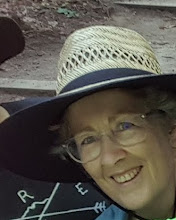"The purpose of the Early Internship is to expose the candidate to the school environment and introduce the school culture in the selected environment." (Syllabus LIBS 6989)
"What a long, strange trip it's been." (Grateful Dead)
I'm a Luddite. And an "older" American. I come to new technologies slowly and with great reluctance. But in 2000, home with children and a growing mail order business, it was time to get an "internet" ready computer. (Does anyone out there remember when a modem was an external device you purchased as an accessory?!) So I needed to learn to use it. And I needed some adult contact beyond just customers placing orders. At the local library, I picked up a flyer about the first completely online program being offered at the local community college. It was for an associates degree in library science. The classes were inexpensive, flexible, and they sounded like a great way to give my aging brain a stretch and give context to learning the new machine. That's where it started.
I took a class a term alongside business and parenting. I loved it. But before I could finish my degree, my husband was killed in a workplace accident in November 2005. The mail order business was good, but not good enough to support us and the LTA (library technical assistant) degree I was earning would not, either. So in January 2006, I enrolled in the online MLS program at East Carolina University and took a part time job in a corporate library in Greensboro. My contract there ended as I earned my degree in May 2008. The economy was tanking long before the Wall Street crash of October 2008, and full time employment for a new gray-haired grad was nearly impossible to find. August 1 I began working as an LTA in a branch of the community college where I'd begun my journey and re-enrolled at ECU and directed the journey towards school media certification, hence this class. The class requires 110 contact hours in a K12 setting in addition to reading, discussion and reflection on education theory and the internship experience.
I am currently the only day-shift library staff in our branch library. My job encompases the full range of daily library operations except for acquisitions which is handled by the evening staff, ILL which is handled on the main campus, and formal library instruction which is handled by the instructional librarian from the main campus. But library orientation, reference, circulation, copy cataloging, promotion, display, intra-consortium borrowing, and anything else that needs to be done falls to me. I love it. I love the students, I love the co-workers. I love the practical stuff I'm learning. And I love helping people, especially with information, which is what librarianship is all about.
So, about the people. We are a small branch campus with a focus on green innovation. We have a sustainable agriculture program that is widely recognized, and a biofuels program that receives requests for graduates from across the country. We plan to offer a natural chef's program when our new LEED certified buildings are completed which includes a new library we will share with the town library. But the core population consists of more typical community college students looking for career training and university preparation. And true to the community college mission, we have a huge continuing education program that ranges from medical training and certification to craft and cake decorating classes. And another large basic skills component that serves adult high school students (AHS), GED students and Huskins students from local high schools getting career training. The main campus has an early college high school and our campus periodically explores the logistics of adding such a program.
Our faculty are typically masters degree or higher with "industry" experience--the kind of boots on the ground experience that helps them prepare students for the workplace well beyond the academic credentials. And they are in the community college system because they love their subject and they love to teach. Because of its small size, there is a real sense of community and collegiality among all the staff members which has made it a really great place to work.
Because the library serves AHS, GED and Huskins students, I have been allowed to earn a third of my contact hours here on campus. The remaining hours have and will be earned visiting K12 settings of various kinds including a year-round school in Apex this summer. I completed most of my checklist for this course in a visit to Randleman Middle School earlier this year and I will use this blog to record more in-depth observations and reflections as required by this course. So we begin.
 This is what it looked like when I arrived at Maddies's middle school for Spring Fling. I almost didn't make it in the torrential rain. Spring Fling is a treat for those students who attended all three days of the EOGs. There were games, food booths, and activities in the gym. And a silent auction as a fund raiser.
This is what it looked like when I arrived at Maddies's middle school for Spring Fling. I almost didn't make it in the torrential rain. Spring Fling is a treat for those students who attended all three days of the EOGs. There were games, food booths, and activities in the gym. And a silent auction as a fund raiser.


























